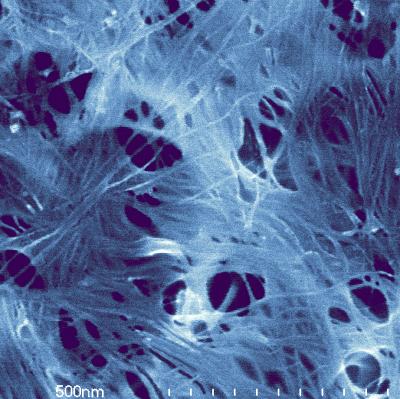Home > Press > Paperwork: Buckypapers Clarify Electrical, Optical Behavior of Nanotubes
 |
| Buckypaper: SEM image demonstrates a pseudo 2-D network of carbon nanotubes deposited like paper fibers in a thin, sparse sheet. The nanotubes here have an average length 820 nm and make a continuous, electrically conducting network overall in spite of obvious gaps. On a macroscale this material would be nearly transparent. Color added for clarity
Credit: Chastek/Talbott NIST |
Abstract:
Using highly uniform samples of carbon nanotubes—sorted by centrifuge for length—materials scientists at the National Institute of Standards and Technology (NIST) have made some of the most precise measurements yet of the concentrations at which delicate mats of nanotubes become transparent, conducting sheets. Their recent experiments* point up the importance of using relatively homogeneous—not overly short, but uniform in length— nanotubes for making high performance conducting films.
Paperwork: Buckypapers Clarify Electrical, Optical Behavior of Nanotubes
GAITHERSBURG, MD | Posted on October 15th, 2008Among their other qualities, single-wall carbon nanotubes (SWCNTs) have attracted much attention as tiny electrical conductors. Relatively small concentrations of nanotubes can change a normally insulating polymer film to a transparent electrical conductor. Potential applications range from transparent electrical shielding materials to futuristic flexible video displays, thin-film chemical sensors and other foldable electronics. One key design parameter for conductive films is the so-called "percolation threshold"—essentially the concentration at which random two- or three-dimensional networks of nanotubes first become electrically conducting.
To test theories on how both the conductance and optical properties of such nanotube-infused films depend on the length of the tubes, the NIST team made samples of "buckypaper" by mixing nanotubes in water and draining the water away through nanoscale filters to leave behind a delicate nanotube mat. The highly refined, length-sorted nanotube samples were produced by an efficient technique developed earlier by the NIST group (see "Spin Control: New Technique Sorts Nanotubes by Length").
The NIST measurements validated one theory: buckypaper made of length-sorted carbon nanotubes closely follows the percolation theory for ideal two-dimensional sheets, with concentration threshold for conductivity getting lower as the tubes get longer. A sheet of 820 nanometer long nanotubes becomes conducting at an amazingly low 18 nanograms per square centimeter, the lowest yet reported. Interestingly, batches of short nanotubes or mixed-length batches form more three-dimensional networks that perform noticeably worse. On the other hand, predictions that optically the sheets would behave like thin metallic films turn out not to be the case. Optical properties are better predicted by the same general percolation theory, say the NIST researchers, which will provide a convenient theoretical framework for designing and engineering nanotech applications with these materials.
* D. Simien, J.A. Fagan, W. Luo, J.F. Douglas, K. Migler and J. Obrzut. Influence of nanotube length on the optical and conductivity properties of thin single-wall carbon nanotube networks. ACS Nano, Vol.. 2 , No. 9, 1879-1884.
####
For more information, please click here
Contacts:
Michael Baum
301-975-2763
Copyright © National Institute of Standards and Technology (NIST)
If you have a comment, please Contact us.Issuers of news releases, not 7th Wave, Inc. or Nanotechnology Now, are solely responsible for the accuracy of the content.
| Related News Press |
News and information
![]() Researchers develop molecular qubits that communicate at telecom frequencies October 3rd, 2025
Researchers develop molecular qubits that communicate at telecom frequencies October 3rd, 2025
![]() Next-generation quantum communication October 3rd, 2025
Next-generation quantum communication October 3rd, 2025
![]() "Nanoreactor" cage uses visible light for catalytic and ultra-selective cross-cycloadditions October 3rd, 2025
"Nanoreactor" cage uses visible light for catalytic and ultra-selective cross-cycloadditions October 3rd, 2025
Nanotubes/Buckyballs/Fullerenes/Nanorods/Nanostrings
![]() Enhancing power factor of p- and n-type single-walled carbon nanotubes April 25th, 2025
Enhancing power factor of p- and n-type single-walled carbon nanotubes April 25th, 2025
![]() Chainmail-like material could be the future of armor: First 2D mechanically interlocked polymer exhibits exceptional flexibility and strength January 17th, 2025
Chainmail-like material could be the future of armor: First 2D mechanically interlocked polymer exhibits exceptional flexibility and strength January 17th, 2025
![]() Innovative biomimetic superhydrophobic coating combines repair and buffering properties for superior anti-erosion December 13th, 2024
Innovative biomimetic superhydrophobic coating combines repair and buffering properties for superior anti-erosion December 13th, 2024
Discoveries
![]() Researchers develop molecular qubits that communicate at telecom frequencies October 3rd, 2025
Researchers develop molecular qubits that communicate at telecom frequencies October 3rd, 2025
![]() Next-generation quantum communication October 3rd, 2025
Next-generation quantum communication October 3rd, 2025
![]() "Nanoreactor" cage uses visible light for catalytic and ultra-selective cross-cycloadditions October 3rd, 2025
"Nanoreactor" cage uses visible light for catalytic and ultra-selective cross-cycloadditions October 3rd, 2025
Announcements
![]() Rice membrane extracts lithium from brines with greater speed, less waste October 3rd, 2025
Rice membrane extracts lithium from brines with greater speed, less waste October 3rd, 2025
![]() Researchers develop molecular qubits that communicate at telecom frequencies October 3rd, 2025
Researchers develop molecular qubits that communicate at telecom frequencies October 3rd, 2025
![]() Next-generation quantum communication October 3rd, 2025
Next-generation quantum communication October 3rd, 2025
![]() "Nanoreactor" cage uses visible light for catalytic and ultra-selective cross-cycloadditions October 3rd, 2025
"Nanoreactor" cage uses visible light for catalytic and ultra-selective cross-cycloadditions October 3rd, 2025
|
|
||
|
|
||
| The latest news from around the world, FREE | ||
|
|
||
|
|
||
| Premium Products | ||
|
|
||
|
Only the news you want to read!
Learn More |
||
|
|
||
|
Full-service, expert consulting
Learn More |
||
|
|
||








